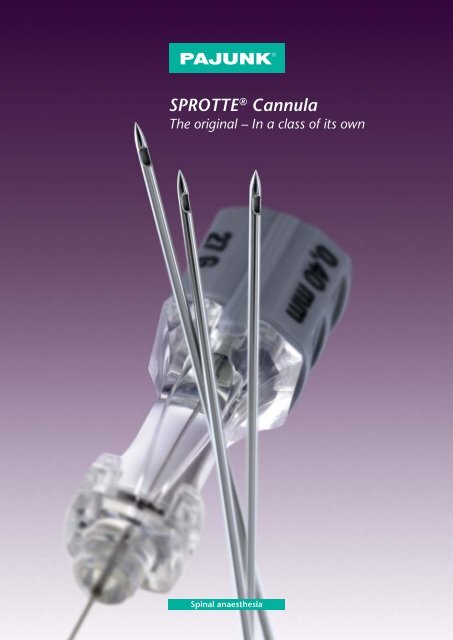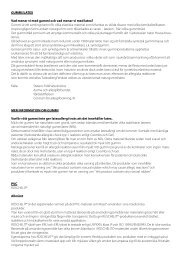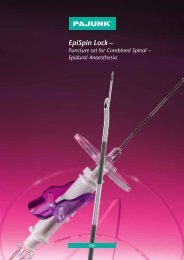SPROTTE® Cannula The original - In a class of
SPROTTE® Cannula The original - In a class of
SPROTTE® Cannula The original - In a class of
- TAGS
- cannula
- www.meteko.se
You also want an ePaper? Increase the reach of your titles
YUMPU automatically turns print PDFs into web optimized ePapers that Google loves.
SPROTTE ® <strong>Cannula</strong><br />
<strong>The</strong> <strong>original</strong> – <strong>In</strong> a <strong>class</strong> <strong>of</strong> its own<br />
Spinal anaesthesia
22 G = 0.70 mm<br />
24 G = 0.55 mm<br />
25 G = 0.50 mm<br />
27 G = 0.40 mm<br />
30 years SPROTTE ® cannula<br />
<strong>The</strong> Success Story in Spinal Anaesthesia<br />
<strong>The</strong> partnership between Pr<strong>of</strong>. Sprotte and<br />
PAJUNK ® began in 1979 with the joint development<br />
<strong>of</strong> the “atraumatic spinal cannula”. This<br />
combination <strong>of</strong> clinical experience and innovative<br />
medical technology was the catalyst from which<br />
spinal anaesthesia established itself as an indispensable<br />
practice in the spectrum <strong>of</strong> modern anaesthesia<br />
methods. By the end <strong>of</strong> the seventies, spinal<br />
anaesthesia was hardly <strong>of</strong> any importance anymore<br />
in the range <strong>of</strong> options open to the anaesthetist.<br />
<strong>The</strong> secret <strong>of</strong> this success is in the unique tip<br />
geometry and basic design <strong>of</strong> the SPROTTE ®<br />
cannula which has been unequalled to this day.<br />
<strong>In</strong> comparison with other cannulas the <strong>original</strong><br />
Colour coded hub<br />
with size information.<br />
without<br />
magnifying<br />
effect<br />
Stylet<br />
<strong>The</strong> limitations which arose from a range <strong>of</strong><br />
frequent and rare complications were too great:<br />
intense headache, nausea, vomiting, low-frequency<br />
hearing loss, abducens nerve paresis and subdural<br />
haematomas. Spinal anaesthesia could no longer<br />
maintain its standing in direct competition with<br />
more mature and sophisticated narcosis methods<br />
which were additionally readily available.<br />
Often copied – but never matched<br />
<strong>The</strong> Original – <strong>In</strong> a Class <strong>of</strong> its Own<br />
provides both patients and users alike with a<br />
considerably greater range <strong>of</strong> functionality, safety<br />
and reliability.<br />
<strong>In</strong>troducer<br />
<strong>The</strong> optional version with magnifying effect is available<br />
so that even the smallest quantities <strong>of</strong> cerebrospinal fl uid<br />
are clearly visible.<br />
with<br />
magnifying<br />
effect
With the SPROTTE ® cannula, the PAJUNK ® development<br />
team has succeeded in manufacturing a<br />
spinal cannula which minimises the numerous side<br />
effects and renders spinal anaesthesia a comfortable<br />
and safe alternative to general anaesthesia.<br />
<strong>The</strong> proven success story confi rms this: For the past<br />
30 years the atraumatic SPROTTE ® cannula has<br />
remained the unchallenged reference point and<br />
standard in spinal anaesthesia and lumbar puncture.<br />
Depending on diameter and length there is a specifi c<br />
introducer available for every cannula size. <strong>The</strong> inner<br />
contours <strong>of</strong> the introducer hub have been designed<br />
so that the atraumatic tip <strong>of</strong> the SPROTTE ® cannula<br />
cannot be damaged during the introduction process.<br />
<strong>Cannula</strong><br />
Many more ideas have been derived and perfected<br />
from the <strong>original</strong> SPROTTE ® cannula.<br />
This has led to a group <strong>of</strong> products which has<br />
become the standard in anaesthesia and pain<br />
therapy fi nding use in a wide variety <strong>of</strong> applications<br />
in everyday clinical work. <strong>The</strong> SPROTTE ® cannula<br />
has therefore made an essential contribution to<br />
the development <strong>of</strong> the fi eld <strong>of</strong> spinal anaesthesia.<br />
<strong>The</strong> ogive-shaped tip<br />
geometry provides<br />
the cannula with its<br />
atraumatic qualities.<br />
7 mm<br />
6 mm<br />
5 mm<br />
4 mm<br />
3 mm<br />
2 mm<br />
1 mm<br />
0 mm<br />
<strong>The</strong> optimal solution for every<br />
application:<br />
A wide range <strong>of</strong> cannulas in<br />
different diameters and lengths<br />
accommodates the most exacting<br />
individual requirements.<br />
Special designs for paediatrics<br />
and SPROTTE ® cannulas for<br />
overweight adults complete<br />
the range.
<strong>The</strong> <strong>original</strong> SPROTTE ® cannula<br />
<strong>The</strong> Guarantor for Atraumatic Puncture<br />
<strong>The</strong> atraumatic qualities <strong>of</strong> the SPROTTE ® cannula is proven histologically and functionally:<br />
Ogive-shaped tip geometry<br />
<strong>The</strong> closed tip <strong>of</strong> the cannula has the shape <strong>of</strong> an ogive. It displaces<br />
the tissue during the puncture process without injuring it. <strong>The</strong> multilayered<br />
texture <strong>of</strong> the dura consisting <strong>of</strong> collagen and elastic fi bres<br />
will close again after the cannula is removed.<br />
Lateral eye with rounded edge<br />
<strong>The</strong> lateral opening <strong>of</strong> the SPROTTE ® cannula is completely free <strong>of</strong><br />
burs and has atraumatically rounded edges. This quality characteristic<br />
provides perfect and smooth gliding features and minimises coring<br />
<strong>of</strong> tissue into the subaranoid space.<br />
Polished stainless steel surface<br />
<strong>The</strong> cannula is manufactured from fi rst-<strong>class</strong> stainless steel which<br />
guarantees optimal stability. <strong>The</strong> surface and the inner lumen have<br />
been polished which reduces any surface roughness to a minimum.<br />
This ensures that the SPROTTE ® cannula can be positioned optimally<br />
to ensure CSF – refl ux is optimised by the greatly reduced internal<br />
surface roughness.<br />
G. Sprotte, R. Schedel, H. Pajunk, H. Pajunk. Eine “atraumatische” Universalkanüle für<br />
einzeitige Regionalanaesthesien, Reg Anaesth. 1987;10(3):104-8<br />
Y. Hirasawa, Y. Katsumi, W. Küsswetter, G. Sprotte. Experimentelle Untersuchungen zur<br />
peripheren Nervenverletzung durch <strong>In</strong>jektionsnadeln, Reg Anaesth. 1990;13:11-15<br />
Ross BK, Chadwick HS, Mancuso JJ, Benedetti C. Sprotte Needle for Obstetric Anesthesia:<br />
Decreased <strong>In</strong>cidence <strong>of</strong> Post Dural Puncture Headache, Reg Anaesth. 1992 Jan-Feb;17(1):29-33.<br />
Lim M, Cross GD, Sold M. Postspinaler Kopfschmerz: Ein Vergleich der 24 G Sprotte-Kanüle<br />
mit einer 29 G Quincke-Kanüle, Anaesthesist 1992;41:539-43<br />
S. Wiesel, M.J. Tessler, L.J. Easdown. Postdural puncture headache: a randomized prospective<br />
comparison <strong>of</strong> the 24 gauge Sprotte and the 27 gauge Quincke needles in young patients,<br />
Can J Anaesth. 1993 Jul;40(7):607-11<br />
D.C. Campbell, M.J. Douglas, T.J. Pavy, P. Merrick, M.L. Flanagan, G.H. McMorland.<br />
Comparison <strong>of</strong> the 25-gauge Whitacre with the 24-gauge Sprotte spinal needle for elective<br />
Caesarean section: cost implications, Can J Anaesth. 1993 Dec;40(12):1131-5<br />
D.A. Harrison, B.T. Langham. Post-dural puncture headache: a comparison <strong>of</strong> the Sprotte and<br />
Yale needles in urological surgery, Eur J Anaesthesiol 1994;11:325-327<br />
D.H. Sears, M.I. Leeman, L.J. Jassy, L.A. O‘Donnell, S.G. Allen, L.S. Reisner. <strong>The</strong> Frequency <strong>of</strong><br />
Postdural Puncture Headache in Obstetric Patients: A Prospective Study comparing the<br />
24-Gauge versus the 22-Gauge Sprotte Needle, J Clin Anesth. 1994;6(1):42-6<br />
C.M. Kumar, M. Metha. Ankylosing spondylitis: lateral approach to spinal anaesthesia for<br />
lower limb surgery, Can J Anaesth. 1995 Jan;42(1):73-6<br />
G. Pittoni, F. T<strong>of</strong>feletto, G. Calcarella, G. Zanette and G.P. Giron. Spinal Anesthesia in<br />
Outpatient Knee Surgery: 22-Gauge Versus 25-Gauge Sprotte Needle, Anesth Analg<br />
1995;81:73-79<br />
T. Standl, S. Eckert, I. Rundshagen, J. Schulte am Esch. A directional needle improves<br />
effectiveness and reduces complications <strong>of</strong> microcatheter continous spinal anaesthesia, Can J<br />
Anaesth. 1995 Aug;42(8):701-5<br />
M.Cesarini, R. Torrielli, F. Lahaye, J.M. Mene, C. Cabiro. Sprotte needle for intrathecal<br />
anaesthesia for Caesarean section: incidence <strong>of</strong> postdural puncture headache, Anaesthesia<br />
1990 Aug;45(8):656-8<br />
J. Fog, L.P. Wang, A. Sundberg, C. Mucchiano. Hearing Loss After Spinal Anesthesia Is Related<br />
to Needle Size, Anesth Analg. (May) 1990;70(5):517-22
<strong>The</strong> effect is obvious:<br />
<strong>In</strong> comparison with conventional cannulas the post spinal headache<br />
rate occurring with an <strong>original</strong> SPROTTE ® cannula is reduced by a<br />
factor <strong>of</strong> 10.<br />
36<br />
4<br />
16<br />
0<br />
Evidence shows that post spinal headaches appear less frequent when the SPROTTE ® cannula is used.<br />
(Results <strong>of</strong> the fi rst controlled study – Jäger et al 1991 Akt. Neurol. 18: 61-64)<br />
<strong>The</strong> use <strong>of</strong> atraumatic cannula will not only reduce<br />
post spinal headaches but, as has been proven,<br />
nuchal rigidity, nausea and vomiting can also be<br />
avoided. <strong>The</strong> recommendation to use atraumatic<br />
cannula can be justifi ed from an economical point<br />
<strong>of</strong> view: the costs <strong>of</strong> medical treatment can be<br />
noticeably reduced by the prevention <strong>of</strong> unwanted<br />
side effects.<br />
16<br />
0<br />
10<br />
0<br />
21 G SPROTTE ® cannula<br />
20 G Quincke cannula<br />
9,3<br />
8<br />
0 0<br />
PDPH Stiffness <strong>of</strong> the neck<br />
(nuchal rigidity)<br />
Nausea Vomiting Vertigo Tinnitus<br />
R. Puolakka, L.C. Andersson. and P.H. Rosenberg. Microscopic Analysis <strong>of</strong> Three Different<br />
Spinal Needle Tips After Experimental Subarachnoid Puncture, Regional Anesthesia and Pain<br />
Medicine, Vol 25, No 2 (March-April) 2000;pp 163-169<br />
M.A. Frölich and D.Caton. Pioneers in Epidural Needle Design, <strong>In</strong>ternational Anesthesia<br />
Research Society, Anesth Analg 2001;93:215-20<br />
M.C. Vallejo, G. L. Mandell, D. P. Sabo and S. Ramanathan. Postdural Puncture Headache: A<br />
Randomized Comparison <strong>of</strong> Five Spinal Needles in Obstetric Patients 2000; Anesth. Analg<br />
2000;91:916-20<br />
H. Jäger, K. Schimrigk, A. Haas. Das postpunktionelle Syndrom – selten bei der Verwendung<br />
der Punktionsnadel nach Sprotte, Akt Neurol 1991;18:61-64<br />
A. Engelhardt, S. Oheim, B. Neundörfer. Post-lumbar-puncture headache: experiences with<br />
Sprotte´s atraumatic needle. Cephalalgia 1992;12:259<br />
B. Müller, K. Adelt, H. Reichmann, K.V. Toyka. Atraumatic needle reduces the incidence <strong>of</strong><br />
post-lumbar puncture syndrome. J Neurol. 1994;241(6):376-80<br />
H.J. Braune, G.A. Huffmann. A prospective double-blind clinical trial, comparing the sharp<br />
Quincke needle (22G) with an “atraumatic” needle (22G) in the induction <strong>of</strong> post-lumbar<br />
puncture headache. Acta Neurol Scand 1992;86 (1):50-54<br />
<strong>The</strong> reduction <strong>of</strong> post spinal headaches by using<br />
atraumatic cannula is proven: Class I evidence,<br />
Type A recommendation (Neurology 2000;<br />
55… 909-914); this is valid for all diameters <strong>of</strong><br />
the atraumatic cannula in use, from 20 Gauge<br />
(Strupp et al Neurology 2001; 57:2310-2312)<br />
to 27 Gauge (Flaatten et al, Acta Anaesthesiol<br />
Scand 2000;44:643-644).<br />
K.V. Toyka, B. Müller, H. Reichmann, M. Strupp, O. Schüler and T. Brandt: Atraumatic Sprotte<br />
needle reduces the incidence <strong>of</strong> post-lumbar puncture headaches, Neurology 2002;59:1120-1121<br />
S. Öhman, J. Ernerudh, P. Forsberg, M. Roberg, M. Vrethem. Lower values for immunoglobulin<br />
M in cerebrospinal fl uid when sampled with an atraumatic Sprotte needle compared with<br />
conventional lumbar puncture, Ann Clin Biochem 1995;32:210-212<br />
D. Vorwerk, J. Reul, R. Casser, C. Schink, R.W. Günther. Atraumatische Sprotte-Nadel zur<br />
Doppelkontrast-CT-Arthrographie des Schultergelenkes, Fortschr Röntgenstr 1993;158:490-492<br />
J.M. Prager, S. Roychowdhury, M.T.Gorey, G.M. Lowe, C.W. Diamond, A.Ragin. Spinal<br />
Headaches After Myelograms: Comparison <strong>of</strong> Needle Types, American Roentgen Ray Society<br />
(Nov.) 1996;167<br />
R.G.T. Fox, W. Reiche, M. Kiefer, T. Hagen und G. Huber: <strong>In</strong>dzidenz des Postmyelographiesyndroms<br />
und postmyelographischer Beschwerden nach lumbaler Punktion mit der bleistiftförmigen<br />
Nadel nach Sprotte im Vergleich zur Nadel nach Quincke, Radiologie 1996;36: 921-927<br />
J. Popp, M. Riad, K. Freymann, F. Jessen: Ambulante Durchführung einer diagnostischen<br />
Lumbalpunktion in der Gedächtnissprechstunde, Der Nervenarzt 5/2007<br />
E.R. Peskind, R. Rieske, J.F. Quinn, J. Kaye, C.M. Clark, M.R. Farlow, C. Decarli, C. Chabal, D.<br />
Vavrek, M.A. Raskind, D. Galasko. Safety and acceptability <strong>of</strong> the research lumbar puncture,<br />
Alzheimer Dis Assoc Disord. 2005;19(4):220-5
Safety through precision and cleanliness<br />
Responsible Handling <strong>of</strong> Cerebrospinal Fluid<br />
Free fl ow <strong>of</strong> cerebrospinal fl uid<br />
Time is a major factor in spinal anaesthesia.<br />
Great effort was therefore made in the design and<br />
manufacture to ensure that cerebrospinal fl uid<br />
fl ows freely without obstruction. <strong>The</strong> time<br />
<strong>In</strong>ner lumen <strong>of</strong> the cannula<br />
<strong>The</strong> smooth inner lumen <strong>of</strong> the cannula provides<br />
for maximum reduction in surface roughness. This<br />
allows optimal refl ux <strong>of</strong> cerebrospinal fl uid.<br />
Lateral opening<br />
<strong>The</strong> lateral opening <strong>of</strong> the cannula directly behind<br />
the tip ensures an unhindered fl ow <strong>of</strong> cerebrospinal<br />
fl uid even if the arachnoidea may be partially<br />
blocking the opening.<br />
Optimal cannula hub<br />
<strong>The</strong> small interior lumen <strong>of</strong> the plastic hub fi lls<br />
quickly with cerebrospinal fl uid allowing it to be<br />
identifi ed faster.<br />
Magnifying effect<br />
Unique to PAJUNK ® : the cannula hub with a<br />
magnifying effect. Even the smallest amount <strong>of</strong><br />
fl uid is clearly identifi ed through a viewing<br />
chamber in the cannula hub.<br />
between puncturing the spinal space and injection<br />
<strong>of</strong> the anaesthetic is substantially reduced when<br />
the SPROTTE ® cannula is used:
<strong>The</strong> Carson study<br />
TIME IN SECONDS<br />
180<br />
150<br />
120<br />
90<br />
60<br />
30<br />
0<br />
SPINOCAN 25 G QUINCKE<br />
SPROTTE 24 G ATRAUMATIC<br />
VYGON 25 G WHITCARE<br />
SPINOCAN 22 G QUINCKE<br />
BD 22 G QUINCKE<br />
BD 22 G WHITACRE<br />
SPROTTE 22 G ATRAUMATIC<br />
VYGON 22 G WHITACRE<br />
SPINOCAN 20 G QUINCKE<br />
SPROTTE 20 G ATRAUMATIC<br />
0 10 20 30 40 50 60 70 80 90 100<br />
Maximum cleanliness<br />
An essential quality aspect and safety feature<br />
directly correlates with the need for cleanliness.<br />
PAJUNK ® operates strict requirements here.<br />
A special multistage cleaning process guarantees<br />
an absolutely clean puncture when using the<br />
SPROTTE ® cannula and simultaneously minimises<br />
the risk to the nervous system. Following the<br />
cleaning operation the SPROTTE ® cannula is<br />
subjected to a special drying process.<br />
<strong>The</strong> outer surface, tip <strong>of</strong> the stylet and lateral<br />
eye <strong>of</strong> the SPROTTE ® cannula are all polished<br />
extensively. <strong>The</strong> extremely smooth steel surface<br />
obtained by this process minimises the risk <strong>of</strong><br />
any metal particle detachment and release into<br />
the cerebrospinal fl uid. Any potential tissue and<br />
blood serum protein deposit is also avoided at<br />
this time. <strong>The</strong> latest equipment, comprehensive<br />
process control and extensive checks within the<br />
PAJUNK ® clean room guarantees maximum<br />
cleanliness and therefore improved safety for<br />
the patient.<br />
PERCENTAGE OF TOTAL CSF HEIGHT REACHED<br />
Pressure transduction <strong>of</strong> a<br />
simulated cerebrospinal fl uid<br />
pressure <strong>of</strong> 24 cm passing through<br />
cannula <strong>of</strong> different manufacturers.<br />
According to Carson D.: Choosing<br />
the best cannula for diagnostic<br />
lumbar puncture Neurology 1996;<br />
47:33-37
Quality characteristic: an extensive range<br />
<strong>The</strong> range in its entirety<br />
<strong>The</strong> well-balanced range <strong>of</strong> products provides the anaesthetist with the option to use suitable cannula<br />
lengths and diameters for every conceivable indication.<br />
SPROTTE ® cannula<br />
Without introducer With introducer Without introducer With introducer<br />
Size Item no. Item no. PU Size Item no. Item no. PU<br />
25 G x 150 mm 061151-29A 10<br />
25 G x 123 mm 151151-29A 10<br />
25 G x 120 mm 031151-29A 051151-29A 10<br />
25 G x 103 mm 041151-29A 25<br />
25 G x 90 mm 501151-29A 021151-29A 25<br />
25 G x 70 mm 021151-29B 25<br />
25 G x 35 mm 001151-29E 25<br />
24 G x 150 mm 141151-30A 131151-30A 10<br />
24 G x 120 mm 031151-30A 041151-30A 10<br />
24 G x 103 mm 521151-30A 021151-30A 25<br />
24 G x 90 mm 001151-30A 121151-30A 25<br />
24 G x 70 mm 001151-30B 021151-30B 25<br />
24 G x 35 mm 001151-30E 25<br />
24 G x 25 mm 001151-30D 25<br />
22 G x 150 mm 041151-30C 141151-30C 10<br />
22 G x 120 mm 031151-30C 131151-30C 10<br />
22 G x 103 mm 521151-30C 221151-30C 25<br />
22 G x 90 mm 001151-30C 021151-30C 25<br />
22 G x 70 mm 051151-30C 051151-30B 25<br />
22 G x 50 mm 071151-30C 25<br />
SPROTTE ® cannula w/ magnifying effect<br />
29 G x 90 mm 501151-28A 25<br />
27 G x 123 mm 231151-27A 10<br />
27 G x 120 mm 151151-27A 10<br />
27 G x 103 mm 141151-27A 25<br />
27 G x 90 mm 121151-27A 25<br />
27 G x 70 mm 121151-27B 25<br />
27 G x 35 mm 111151-27A 25<br />
27 G x 25 mm 101151-27A 25<br />
25 G x 123 mm 251151 29A 10<br />
25 G x 120 mm 171151-29A 10<br />
25 G x 103 mm 161151-29A 25<br />
25 G x 90 mm 521151-29A 511151-29A 25<br />
<strong>In</strong>troducers for the SPROTTE ® cannula<br />
Size Item no. <strong>Cannula</strong> size PU<br />
0.70 x 30 mm 071151-30L 27 G and 29 G 25<br />
0.70 x 40 mm 071151-30M 27 G and 29 G 25<br />
0.80 x 30 mm 021151-30L 24 G and 25 G 25<br />
0.80 x 40 mm 021151-30M 24 G and 25 G 25<br />
1.00 x 30 mm 001151-30L 22 G 25<br />
1.00 x 40 mm 001151-30M 22 G 25<br />
PAJUNK GmbH<br />
Medizintechnologie<br />
Karl-Hall-Strasse 1<br />
D-78187 Geisingen/Germany<br />
Telefon +49 (0) 77 04 /92 91-0<br />
Telefax +49 (0) 77 04 /92 91-6 00<br />
www.pajunk.com<br />
XS200056I 03/09






